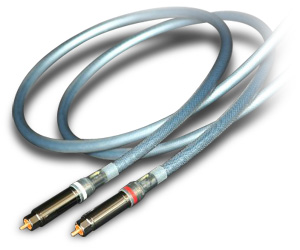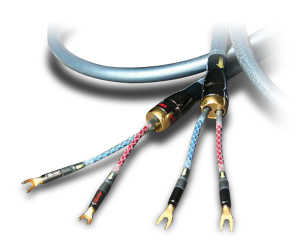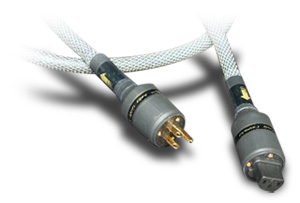 |
|||
| May 1, 2007 Legenburg Iris Interconnects, Speaker Cables, and Power Cords
In "Jack and the Beanstalk," Jack goes to market, where he plans to sell the family cow so that he and his mother can buy food. On the way he meets a fast-talking shyster who tells him a wild tale that seems too good to be true, and talks him into trading the cow for a handful of magic beans. Something about that bean peddler’s talent reminds me of the formidable marketing skills of audio cable manufacturers. On the way to market to buy a perfectly respectable amplifier or CD player, we audiophiles feel a tug on our sleeves and find ourselves listening to the stories of some wild-eyed cable guy. An hour later we wander home with an empty checking account and a bag full of fancy-looking wire, convinced that this is all we need to have a high-fidelity audio system. But if you’re looking for a cautionary tale, neither story suits the purpose. Both end happily. Jack ends up with a pot of gold, and audiophiles have a pretty good chance (if we exercise care) of purchasing reasonably priced yet high-performing audio cables that will allow the rest of our equipment to shine. Case in point: The Iris line of audio cables from Legenburg Professional Cable. It was a good day around our house when Legenburg’s most recent offerings, their Iris interconnects ($672 USD per 3’ pair), speaker wires ($1660 per 8’ pair), and power cables ($672 per 5’ cord), came my way for review. The Legenburg story If you Google "Legenburg," you’ll find almost nothing with that name. No small town in Germany, no members of a Legenburg family. So my first question was: Why call your cables "Legenburg"? The good folks at Legenburg and its parent company, Capativa Technologies, Inc., prefer that the origins of their name remain a mystery. They did allude to the fact that they’re associated with several engineers who have contributed to their cables’ design, and the public record at the US Patent Office reveals that two of these engineers (neither named "Legenburg") hold at least five patents on those designs. Impressive, to say the least. Perhaps reflecting this engineering-oriented viewpoint, Legenburg prefers I not write about their designers’ personal histories and instead focus on the design and quality of their cables. In an industry in which personal history is often the stuff of marketing departments, I’m happy to oblige.
Legenburg cables are a marriage of automated and hand assembly. The cables’ raw materials are imported from Neotech in Taiwan, but the final products are assembled in the US, where maximum quality in the process can be maintained. The patented cable designs use various gauges of rectangular Ohno continuous crystal (OCC) copper or silver wire in each conductor to minimize the skin effect and thus improve the quality of high-frequency reproduction. (Legenburg’s patents are not on the rectangular wire itself, which is used by another audio cable company as well as for non-audio purposes, but on the design of the entire cable.) Legenburg’s own names for the wire, mono-crystal rectangular pure copper (MCRPC) and mono-crystal rectangular pure silver (MCRPS), represent both the design and quality of the wire. Legenburg selects and incorporates other materials into their designs with similar care. Several types of Teflon (a thin Teflon skin over each wire, Teflon tape, and foamed Teflon), as well as air tubes, are used as insulators with low-dielectric constants to minimize resonance issues. Plugs and connectors are of mono-crystal copper plated in gold or rhodium; no nickel finishes are used. The solder used to attach cables to connectors is lead-free copper and silver. The geometry of the speaker cables and power cords consists of multiple layers of rectangular wire spiraling in opposite directions around a hollow central core. Legenburg makes several lines of cables. I was impressed that, unlike many cable companies, their most expensive wire costs about four times as much as their least expensive. Their highest-end line, Zeus, uses MCRPS silver wire; an 8’ pair of Zeus speaker cables runs a cool $6850 per 8’ pair. Below that are the Apollo Mark 2, Hermes, and Artemis lines, and by the time you reach the bottom, the Iris line, similar-length speaker cables using MCRPC copper wire cost $1660 per 8’ pair. Although I use the word mere in a purely relative sense, I think that the Irises’ prices are not out of line with what your ears get. Furthermore, the folks at Legenburg made a point of telling me that the differences between cables in the Iris and Zeus lines are not a matter of materials quality, which they maintain in all their products, but of design. Even the cases for the cables exude quality. The Iris interconnects came securely packaged in a conventional but upscale printed cardboard box, but the speaker cables and power cords came in their own handsomely finished wooden cases. There’s something gratifying and a bit humbling about opening a speaker-cable case that itself looks to be of better quality than your first stereo. Associated equipment for this review included a PS Audio Premier Power Plant power conditioner, Cary Audio 306/200 CD player, Bent Audio NOH passive transformer-based line stage, Conrad-Johnson Premier 350 power amp, Triangle Stratos Australe speakers, AudioQuest Panther interconnects and NRG-5 power cables, and Paul Speltz Anti-Cable speaker cables. Listening to all Psychologists have theories about all sorts of things; it’s part of our training. One of my own theories (and my experience) is that, if you want to evaluate an unfamiliar B against a highly familiar A, B/A comparisons are better than A/B comparisons. The idea is that if you take time to get used to B and then switch to the already familiar A, you’ll have a better understanding of B than you would if you were trying to make sense of what B sounds like in the first few minutes of a comparison against A, which you know in your sleep. So I replaced all of my reference wires with Legenburgs, let them burn in for a week or so, and then started serious listening. With the entire Legenburg Iris cable system in place, I played some recordings of acoustic instruments. The sound had made a remarkable shift toward more natural-sounding timbres. Violins developed a richness and solidity to their tone, yet the micromechanics of bow against string were clearer and more impactful. Reeds such as oboes and bassoons became more textured and detailed, with deeper resonance and richer harmonics. Musical details came out of the background more easily, and the soundstage was deeper, wider, and taller. The word that came to me over and over was presence -- as more easily imagined realities in my listening room, human voices and all types of instruments made themselves not only heard but felt. The other inescapable word was tubes -- the Legenburg cables had the solid, persuasive, slightly warm authority of modern tube components while maintaining good detail, particularly in the midrange. After the first listening sessions, though, I began to feel that all was not sounding quite right at the very top end. The Legenburg cables seemed slightly rolled-off or soft compared to my references. But something bothered me about that conclusion, too. I kept listening over and over to sort it out. It finally took sitting 12’ away from the three live singers of a cappella Celtic group Navan, and bagpiper Sean Michael Dargan, at a private indoor concert sponsored by Wisconsin Public Radio (thankfully he was playing the relatively subdued "parlor pipes," not the Highland version), to remind me that what I was hearing with the Legenburg cables was not a loss of high-end treble, but treble closer to the way it really is. The higher-end harmonics of the live bagpipes were shrill but relatively smooth and undistorted, and that’s what I’d been hearing with the Legenburgs. With that insight, I took out a favorite CD, Vivaldi Wind Concertos, that I hadn’t listened to for a while. It includes the Concerto for Piccolo, Strings and Continuo in C Major, RV 443, performed by soloist William Bennett and the Academy of St. Martin-in-the-Fields, conducted by Neville Marriner [CD, Philips 028946064528]. Sure enough, the piccolo sounded more solid and smooth with the Legenburg cables, yet its higher harmonics increased in believability and were less irritating than with my references. As best I could tell, while the very highest metallic shimmer of a cymbal might still have been a bit soft, it sounded as if the Legenburg cables were substantially reducing high-frequency distortion. At the other end of the frequency spectrum, the Legenburgs also handled bass extremely well. Again, at first listen there seemed to be a slight softening of the bass, but two factors argued against that being the entire explanation. First, bass notes had more timbre and tone, which made them more believable and satisfying, and certainly had something to do with an increase in resolution, not a decrease. Second, on cuts such as "The Gates of Istanbul," from Loreena McKennitt’s recent CD, An Ancient Muse [CD, Verve B000792002], whose variety of string and percussive bass and midbass tones can really test a system, there was extensive detail and an even better sense of being able to listen into the music. Again, what I was hearing with the bass as well as with the treble was lower distortion and a greater sense of you-are-there reality. I doubt that the Irises took me to the end of the line of those qualities -- Legenburg’s higher-priced lines presumably exist for a reason, and the company explicitly notes the higher resolution and extension achieved by their Apollo and Zeus lines -- but the overall effect was nonetheless unprecedented in my system. I was amazed enough at what I was hearing to ask Larry, an audiophile friend, to come by for a listen. He sat stone-faced through the first two tracks of Vangelis’s Blade Runner soundtrack [CD, Atlantic 82623-2], then asked to hear "Cheek to Cheek," from Eva Cassidy’s Live at Blues Alley [CD, Blix Street G2 10046]. Halfway through the Cassidy track he began to nod, and didn’t stop nodding for at least a minute. "Don’t change anything," he said emphatically. "This is as good as I’ve ever heard your system. Except for the bottom half-octave, it sounds as good as mine." For Larry, this is very high praise (his "bottom half-octave" comment refers to the fact that his Vandersteen 5a speakers have built-in subwoofers). Unfortunately, it is the nature of this reviewing beast to want to change things. Within a few days, I was listening to the comparisons I wanted to make among individual Iris cables. Listening to one The second part of my listening trial involved making comparisons between individual Legenburg wires and my references. I tried swapping them out both ways: listening to how the individual Legenburgs sounded in the context of my reference cables, and how my references sounded surrounded by the Legenburgs. The magnitude and quality of the differences reported below are likely to not be exactly duplicable on your system, because your present cables are probably different from mine. But I’d be surprised if your own tests didn’t move you at least in the direction of what I heard. The Iris interconnects gave music a more solid presence than my reference AudioQuest Panthers, with strong, smooth, yet detailed and textured individual tones. Although the difference was clearly noticeable, it was somewhat smaller in magnitude than the difference between my reference power and speaker cables and their Iris counterparts. I suspect this was partly due to both sets of interconnects using similar materials (OCC copper, Teflon dielectric) but different shapes (round vs. rectangular wires) and cable geometry. This was where I felt the designs of the Legenburg cables were most telling: The materials used are important, but so are their shapes and how they’re put together. The comparison of speaker cables was particularly interesting. I’d used the inexpensive, out-of-the-mainstream Paul Speltz Anti-Cables for well over a year because they sounded better to me than any other reasonably affordable speaker cable I’d tested them against. Like the Legenburgs, the Anti-Cables are also made of OCC copper -- in this case a single, enamel-insulated 12-gauge wire for each conductor that I’d terminated with Eichmann bayonet banana plugs. What the Legenburg Iris provided -- admittedly, for an additional $1500/pair -- was a smoother, less grainy tone with even more detail than the Speltzes, less apparent distortion, and more natural-sounding timbres. The sense of presence was greater as well -- the Legenburg Irises threw up a bigger, more precise soundstage.
Legenburg’s Iris AC cords, too, made unmistakable differences. First, voices and pianos were richer. My reference AudioQuest NRG-5 cords sounded perhaps more precise, but at the cost of sounding thinner, with a loss of harmonic richness. This was particularly evident with percussion instruments, which sounded clearer and more realistic -- there’s a world of difference between a wood block that sounds natural and one that doesn’t. In his vocal performances on Revival [CD, Chissa HUCD 3093], Hugh Masekela sounded ten years younger through the AudioQuest cords -- not a good thing, since his voice was now missing some deeper intonations and detail. The Legenburg cords also provided more detail and tone in this recording’s many complex choral passages. Considerations and conclusions Neotech, the Taiwanese firm that is the source for Legenburg’s cables, is also responsible for much of the mono-crystal wire used in audio gear, and has received positive reviews for their own lines of audio cable, made of materials similar to those used in the Legenburg designs. Capativa Technologies, the US distributor for Neotech cables, will be offering these as a lower-cost option to their own Legenburg models. Legenburg cables are not currently cryogenically treated, but I was told that they will be in the near future. The company thinks that cryogenic treatment will be most useful in reducing slight, individual variations in the molecular structure of hand-soldered connections. From my own experience of listening to cryogenically treated cables, I would guess that the process would also build on the Legenburg strengths of smoothness and solidity of tone, while adding to the detail offered by these wires. During the time I listened to the Legenburg cables, I found information about them hard to come by. The cables were accompanied by an outdated brochure describing several products that are no longer available and omitting some that are, including the review models. Even the Legenburg website was "temporarily unavailable" during the three months I evaluated their cables, and was still unavailable when I submitted this review. I’m grateful for the company’s willingness to talk to me by e-mail and telephone about their products, but they’ll have a hard time making a commercial success of their products if they can’t get current information about them into the hands of potential buyers. My hope is that, by the time you read this paragraph, you’ll be able to ignore it and get all the information you need about their cables from Legenburg themselves. Whatever Legenburg Professional Cable’s communication issues may be, the Irises are something very special. They have been soundly designed and engineered, and I found the audible results extraordinarily pleasing. They allowed me to push the other components and elements in my system toward greater resolution and quality while minimizing distortion, and gave me the knowledge that I had plenty of tonal realism in reserve. The Irises made such a profound improvement in the sound of my system that I’m making them my first Ultra Audio Select Component for a state-of-the-art value at their price points. I’m also making arrangements to save Legenburg the return shipping charges. When you find a pot of gold, you don’t give it up. …Albert Bellg Legenburg Iris Interconnects Legenburg Professional Cable Website: www.legenburg.com
Ultra Audio is part of the SoundStage! Network. |



